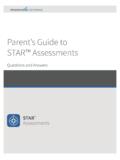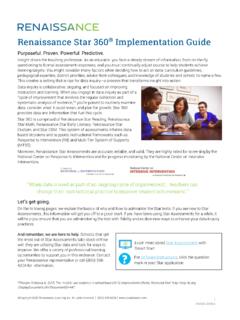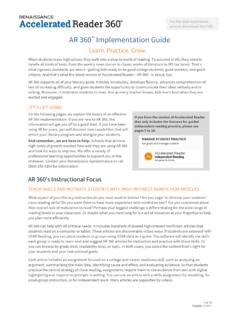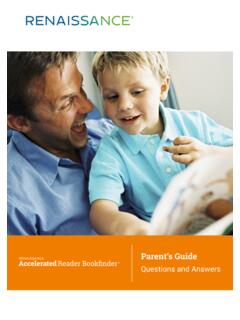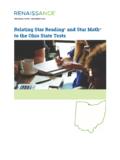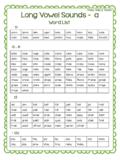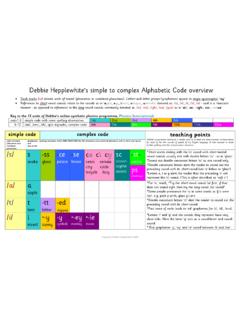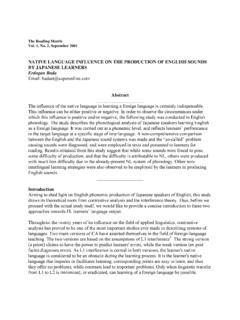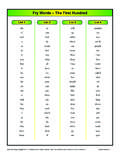Transcription of Renaissance Star Early Literacy : Score Definitions
1 Renaissance star Early Literacy : Score Definitions Renaissance star Early Literacy scores represent how well a student understands concepts and possesses specific skills that are important in the development of reading ability. These scores represent a snapshot of achievement at a specific point in time. As with any assessment, it is important to remember that many factors can affect a student's scores. Renaissance star Early Literacy scores give only one picture of how well a student is doing in school. Scaled Score (SS) is calculated based on the difficulty of items and the number of correct responses.
2 Because the same range is used for all students, scaled scores can be used to compare student performance across grade levels. star Early Literacy scaled scores range from 300 to 900 and relate directly to the Literacy classifications. Literacy classifications are the stages of Literacy development measured in star Early Literacy and associated with scaled scores: Emergent Reader (300 674), Transitional Reader (675 774), and Probable Reader (775 900). These stages are an easy way to monitor student progress: Emergent Reader (300 674). Early Emergent Reader (300 487): Student is beginning to understand that printed text has meaning.
3 The student is learning that reading involves printed words and sentences, and that print flows from left to right and from the top to the bottom of the page. The student is also beginning to identify colors, shapes, numbers, and letters. Late Emergent Reader (488 674): Student can identify most of the letters of the alphabet and can match most of the letters to their sounds. The student is also beginning to read picture books and familiar words around the home. Through repeated reading of favorite books with an adult, students at this stage are building their vocabularies, listening skills, and understandings of print.
4 Transitional Reader (675 774): Student has mastered alphabet skills and letter-sound relationships. The student can identify many beginning and ending consonant sounds and long and short vowel sounds, and is probably able to blend sounds and word parts to read simple words. The student is also likely using a variety of strategies to figure out words, such as pictures, story patterns, and phonics. Probable Reader (775 900): Student is becoming proficient at recognizing many words, both in and out of context. The student spends less time identifying and sounding out words, and more time understanding what was read.
5 Probable readers can blend sounds and word parts to read words and sentences more quickly, smoothly, and independently than students in the other stages of development. Domain Scores estimate a student's mastery of each domain for the student's grade level. For example, a domain Score of 50 for a 5th grader means the student would be expected to answer correctly approximately 50 percent of the fifth-grade items in that domain. Copyright 2017 Renaissance Learning, Inc. All rights reserved. | (800) 338-4204 | 1. Literacy sub-domain Score is a criterion-referenced Score that represents the percentage of items a student would be expected to answer correctly within a sub-domain.
6 Literacy sub-domain scores range from 0 to 100 in ten areas, covering 41 skill sets, which contain 145 separate Literacy skills: Alphabetic Principle (AP) assesses a student's knowledge of letter names, alphabetic letter sequences, and the sounds associated with letters. Concept of Word (CW) assesses a student's understanding of print concepts regarding written word length and word borders and the difference between words and letters. Visual Discrimination (VS) assesses a student's ability to differentiate both upper- and lowercase letters, identify words that are different, and match words that are the same.
7 Phonemic Awareness (PA) assesses a student's understanding of rhyming words; blending and segmenting word parts and phonemes; isolating and manipulating initial, final, and medial phonemes; and identifying the sounds in consonant blends. Phonics (PH) assesses a student's understanding of short, long, and variant vowels and other vowel sounds;. initial and final consonants; consonant blends and digraphs; consonant and vowel substitution; and identification of rhyming words and sounds in word families. Structural Analysis (SA) assesses a student's understanding of affixes and syllable patterns in decoding and identification of compound words.
8 Vocabulary (VO) assesses a student's knowledge of high-frequency words, regular and irregular sight words, multi-meaning words, words used to describe categorical relationships, position words, synonyms and antonyms. Sentence-Level Comprehension (SC) assesses a student's ability to identify the meaning of words in contextual sentences. Paragraph-Level Comprehension (PC) assesses a student's ability to identify the main topic of text and the ability to answer literal and inferential questions after listening to or reading text. Early Numeracy (EN) assesses a student's ability to identify and name numbers; understand number-object correspondence; complete sequences; compose and decompose groups of up to ten; and compare sizes, weights, and volumes.
9 Student Growth Percentile (SGP) is a norm-referenced quantification of individual student growth derived using quantile regression techniques. An SGP compares a student's growth to that of his or her academic peers nationwide. SGPs range from 1 99 and interpretation is similar to that of Percentile Rank scores; lower numbers indicate lower relative growth and higher numbers show higher relative growth. For example, an SGP of 70 means that the student's growth from one test window to another exceeds the growth of 70% of students nationwide in the same grade with a similar achievement history.
10 Skill Score is a criterion-referenced Score that estimates a student's percent of mastery of specific skills within each of the ten sub-domains. Skill scores range from 0 to 100. Estimated Oral Reading Fluency (Est. ORF) is an estimate of a student's ability to read words quickly and accurately in order to comprehend text efficiently. Students with oral reading fluency demonstrate accurate decoding, automatic word recognition, and appropriate use of the rhythmic aspects of language ( , intonation, phrasing, pitch, and emphasis). Est. ORF is reported in correct words per minute, and is based on a known relationship between star Early Literacy performance and oral reading fluency.
